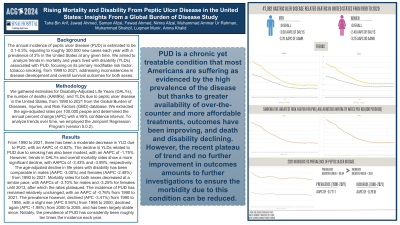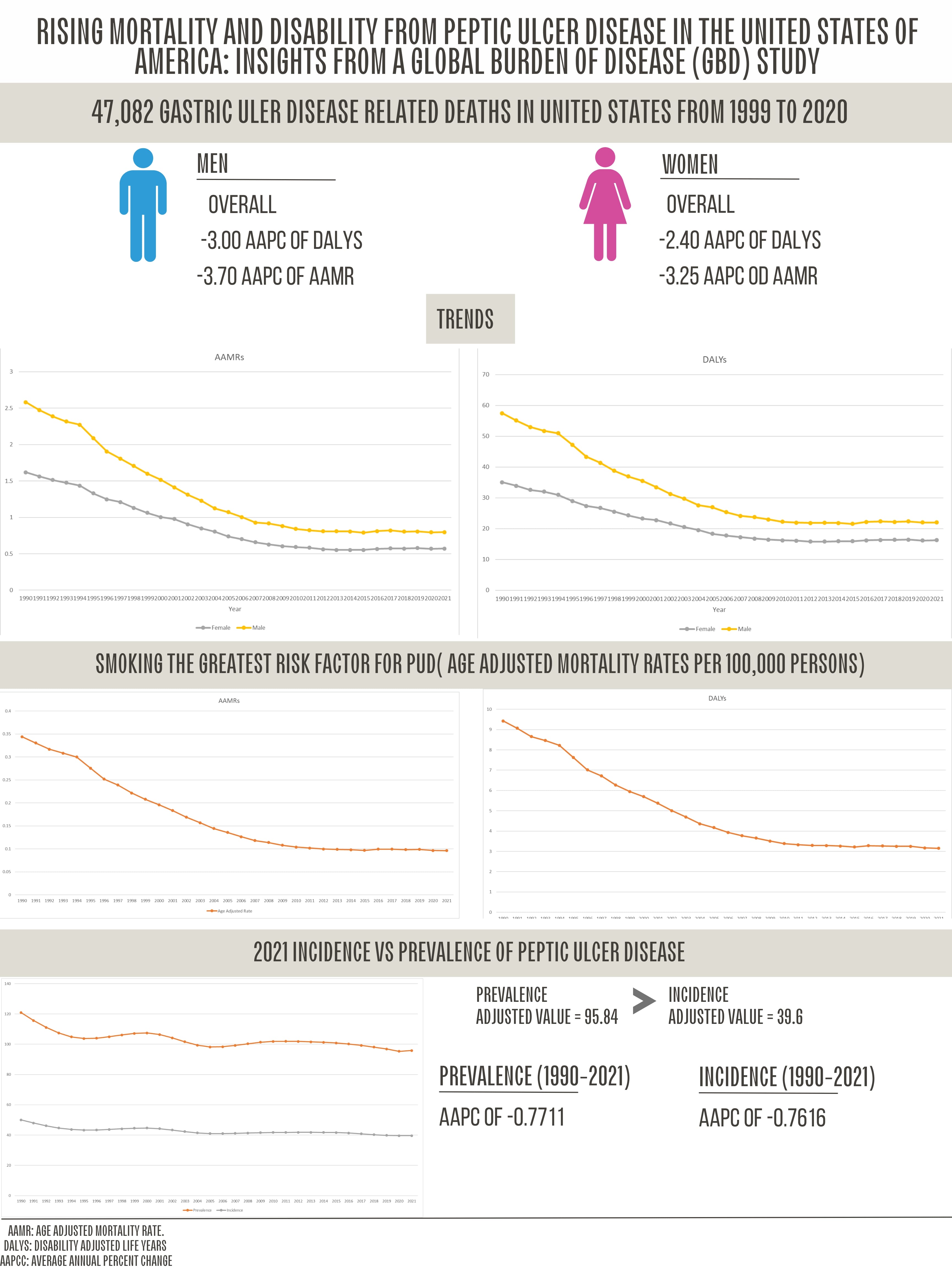Sunday Poster Session
Category: Stomach
P1613 - Rising Mortality and Disability From Peptic Ulcer Disease in the United States: Insights From a Global Burden of Disease Study
Sunday, October 27, 2024
3:30 PM - 7:00 PM ET
Location: Exhibit Hall E

Has Audio

Taha Bin Arif, MBBS, MD
Sinai Hospital
Baltimore, MD
Presenting Author(s)
Taha Bin Arif, MBBS, MD1, Jawad Ahmed, MBBS2, Saman Afzal, MBBS2, Fawad Ahmed, MBBS2, Nimra Afzal, MBBS2, Muhammad Ammar Ur Rahman, MBBS2, Muhammad Shahzil, MD3, Luqman Munir, MBBS2, Amna Khalid, MBBS2
1Sinai Hospital, Baltimore, MD; 2King Edward Medical University, Lahore, Punjab, Pakistan; 3Penn State Health Milton S. Hershey Medical Center, Hershey, PA
Introduction: The annual incidence of peptic ulcer disease (PUD) is estimated to be 0.1-0.3%, equating to roughly 300,000 new cases each year with a prevalence of 3% in the United States at any given time. We aimed to analyze trends in mortality and years lived with disability (YLDs) associated with PUD, focusing on its primary modifiable risk factor, tobacco smoking, from 1999 to 2021, addressing inconsistencies in disease development and overall survival outcomes for both sexes.
Methods: We gathered estimates for Disability-Adjusted Life Years (DALYs), the number of deaths (AAMRs), and YLDs due to peptic ulcer disease in the United States, from 1990 to 2021 from the Global Burden of Diseases, Injuries, and Risk Factors (GBD) database. We extracted the age-adjusted rates per 100,000 people and determined the annual percent change (APC) with a 95% confidence interval. To analyze trends over time, we employed the Joinpoint Regression Program (version 5.0.2).
Results: From 1990 to 2021, there has been a moderate decrease in YLD due to PUD, with an AAPC of -0.82%. The decline in YLDs related to PUD due to smoking has also been modest, with an AAPC of -1.75%. However, trends in DALYs and overall mortality rates show a more significant decline, with AAPCs of -3.43% and -3.99%, respectively. The age-adjusted decline in life years with disability has been comparable in males (AAPC -3.00%) and females (AAPC -2.48%) from 1990 to 2021. Mortality rates for both sexes decreased at a similar pace, with AAPCs of -3.70% for males and -3.25% for females until 2013, after which the rates plateaued. The incidence of PUD has remained relatively unchanged, with an AAPC of -0.76% from 1990 to 2021. The prevalence however, declined (APC -3.41%) from 1990 to 1995, with a slight rise (APC 0.94%) from 1995 to 2000, declined again (APC -1.98%) from 2000 to 2005, and has been largely stable since. Notably, the prevalence of PUD has consistently been roughly ten times the incidence each year.
Discussion: PUD is a chronic yet treatable condition that most Americans are suffering from as evidenced by the high prevalence of the disease but thanks to greater availability of over-the-counter and more affordable treatments, outcomes have been improving, and death and disability declining. However, the recent plateau of trend and no further improvement in outcomes amounts to further investigations to ensure the morbidity due to this condition can be reduced.

Disclosures:
Taha Bin Arif, MBBS, MD1, Jawad Ahmed, MBBS2, Saman Afzal, MBBS2, Fawad Ahmed, MBBS2, Nimra Afzal, MBBS2, Muhammad Ammar Ur Rahman, MBBS2, Muhammad Shahzil, MD3, Luqman Munir, MBBS2, Amna Khalid, MBBS2. P1613 - Rising Mortality and Disability From Peptic Ulcer Disease in the United States: Insights From a Global Burden of Disease Study, ACG 2024 Annual Scientific Meeting Abstracts. Philadelphia, PA: American College of Gastroenterology.
1Sinai Hospital, Baltimore, MD; 2King Edward Medical University, Lahore, Punjab, Pakistan; 3Penn State Health Milton S. Hershey Medical Center, Hershey, PA
Introduction: The annual incidence of peptic ulcer disease (PUD) is estimated to be 0.1-0.3%, equating to roughly 300,000 new cases each year with a prevalence of 3% in the United States at any given time. We aimed to analyze trends in mortality and years lived with disability (YLDs) associated with PUD, focusing on its primary modifiable risk factor, tobacco smoking, from 1999 to 2021, addressing inconsistencies in disease development and overall survival outcomes for both sexes.
Methods: We gathered estimates for Disability-Adjusted Life Years (DALYs), the number of deaths (AAMRs), and YLDs due to peptic ulcer disease in the United States, from 1990 to 2021 from the Global Burden of Diseases, Injuries, and Risk Factors (GBD) database. We extracted the age-adjusted rates per 100,000 people and determined the annual percent change (APC) with a 95% confidence interval. To analyze trends over time, we employed the Joinpoint Regression Program (version 5.0.2).
Results: From 1990 to 2021, there has been a moderate decrease in YLD due to PUD, with an AAPC of -0.82%. The decline in YLDs related to PUD due to smoking has also been modest, with an AAPC of -1.75%. However, trends in DALYs and overall mortality rates show a more significant decline, with AAPCs of -3.43% and -3.99%, respectively. The age-adjusted decline in life years with disability has been comparable in males (AAPC -3.00%) and females (AAPC -2.48%) from 1990 to 2021. Mortality rates for both sexes decreased at a similar pace, with AAPCs of -3.70% for males and -3.25% for females until 2013, after which the rates plateaued. The incidence of PUD has remained relatively unchanged, with an AAPC of -0.76% from 1990 to 2021. The prevalence however, declined (APC -3.41%) from 1990 to 1995, with a slight rise (APC 0.94%) from 1995 to 2000, declined again (APC -1.98%) from 2000 to 2005, and has been largely stable since. Notably, the prevalence of PUD has consistently been roughly ten times the incidence each year.
Discussion: PUD is a chronic yet treatable condition that most Americans are suffering from as evidenced by the high prevalence of the disease but thanks to greater availability of over-the-counter and more affordable treatments, outcomes have been improving, and death and disability declining. However, the recent plateau of trend and no further improvement in outcomes amounts to further investigations to ensure the morbidity due to this condition can be reduced.

Figure: Figure 1: Graphical illustration of findings from rising mortality and disability from peptic ulcer disease in the United States.
Disclosures:
Taha Bin Arif indicated no relevant financial relationships.
Jawad Ahmed indicated no relevant financial relationships.
Saman Afzal indicated no relevant financial relationships.
Fawad Ahmed indicated no relevant financial relationships.
Nimra Afzal indicated no relevant financial relationships.
Muhammad Ammar Ur Rahman indicated no relevant financial relationships.
Muhammad Shahzil indicated no relevant financial relationships.
Luqman Munir indicated no relevant financial relationships.
Amna Khalid indicated no relevant financial relationships.
Taha Bin Arif, MBBS, MD1, Jawad Ahmed, MBBS2, Saman Afzal, MBBS2, Fawad Ahmed, MBBS2, Nimra Afzal, MBBS2, Muhammad Ammar Ur Rahman, MBBS2, Muhammad Shahzil, MD3, Luqman Munir, MBBS2, Amna Khalid, MBBS2. P1613 - Rising Mortality and Disability From Peptic Ulcer Disease in the United States: Insights From a Global Burden of Disease Study, ACG 2024 Annual Scientific Meeting Abstracts. Philadelphia, PA: American College of Gastroenterology.
